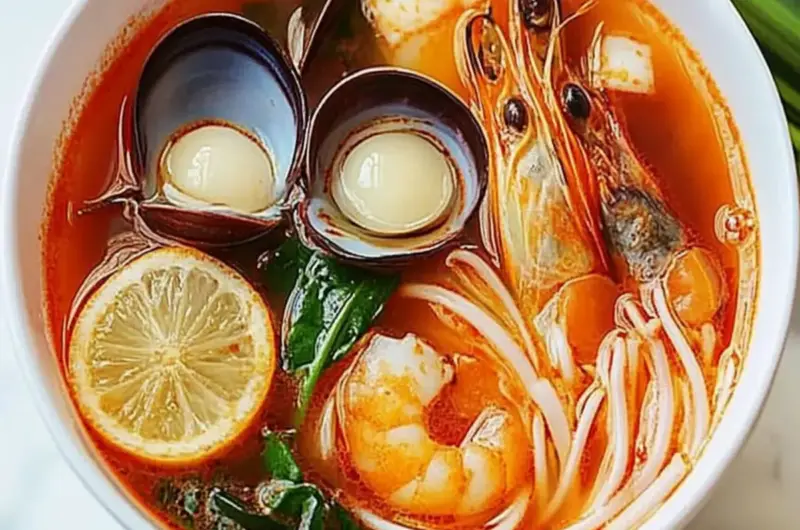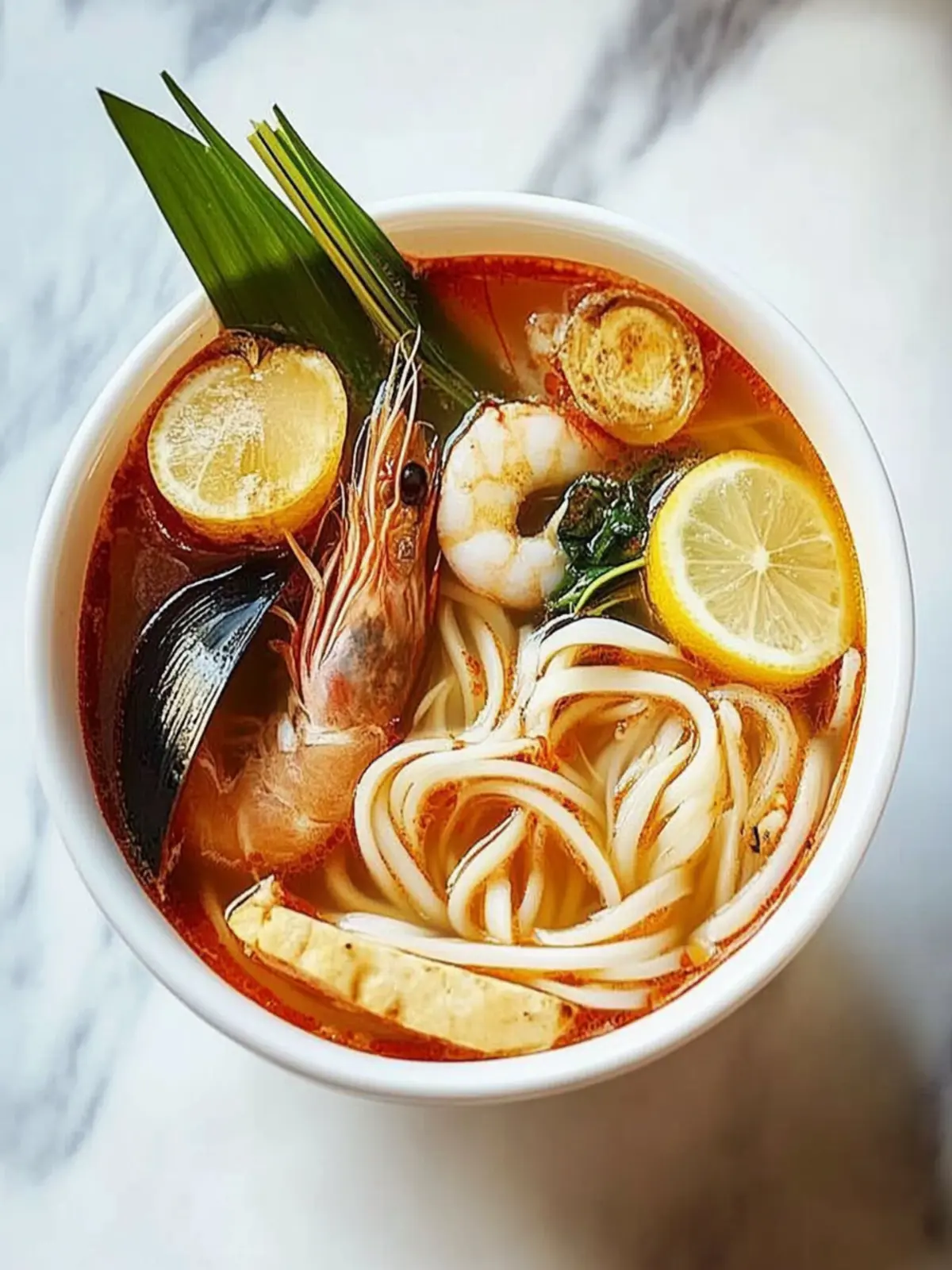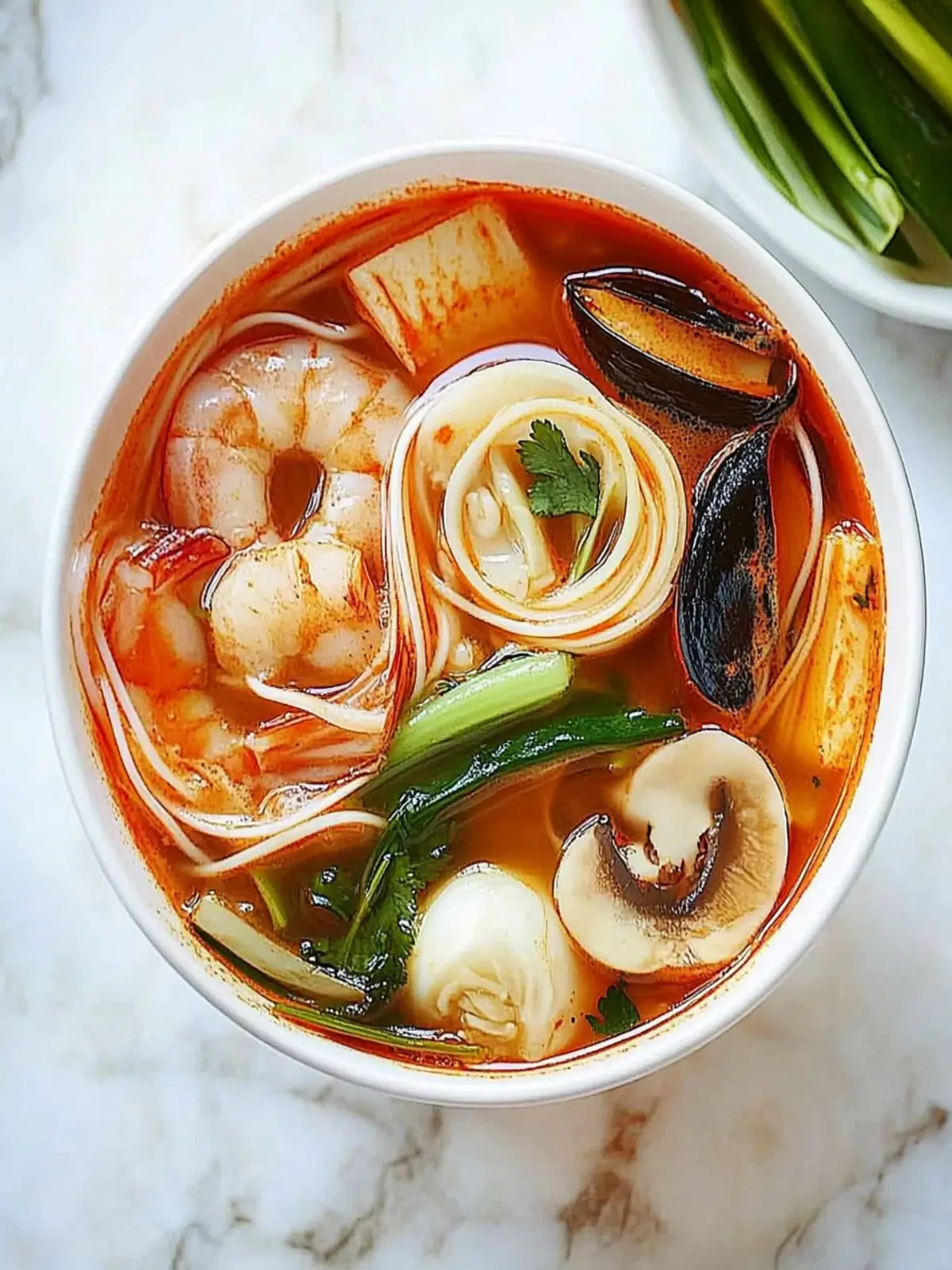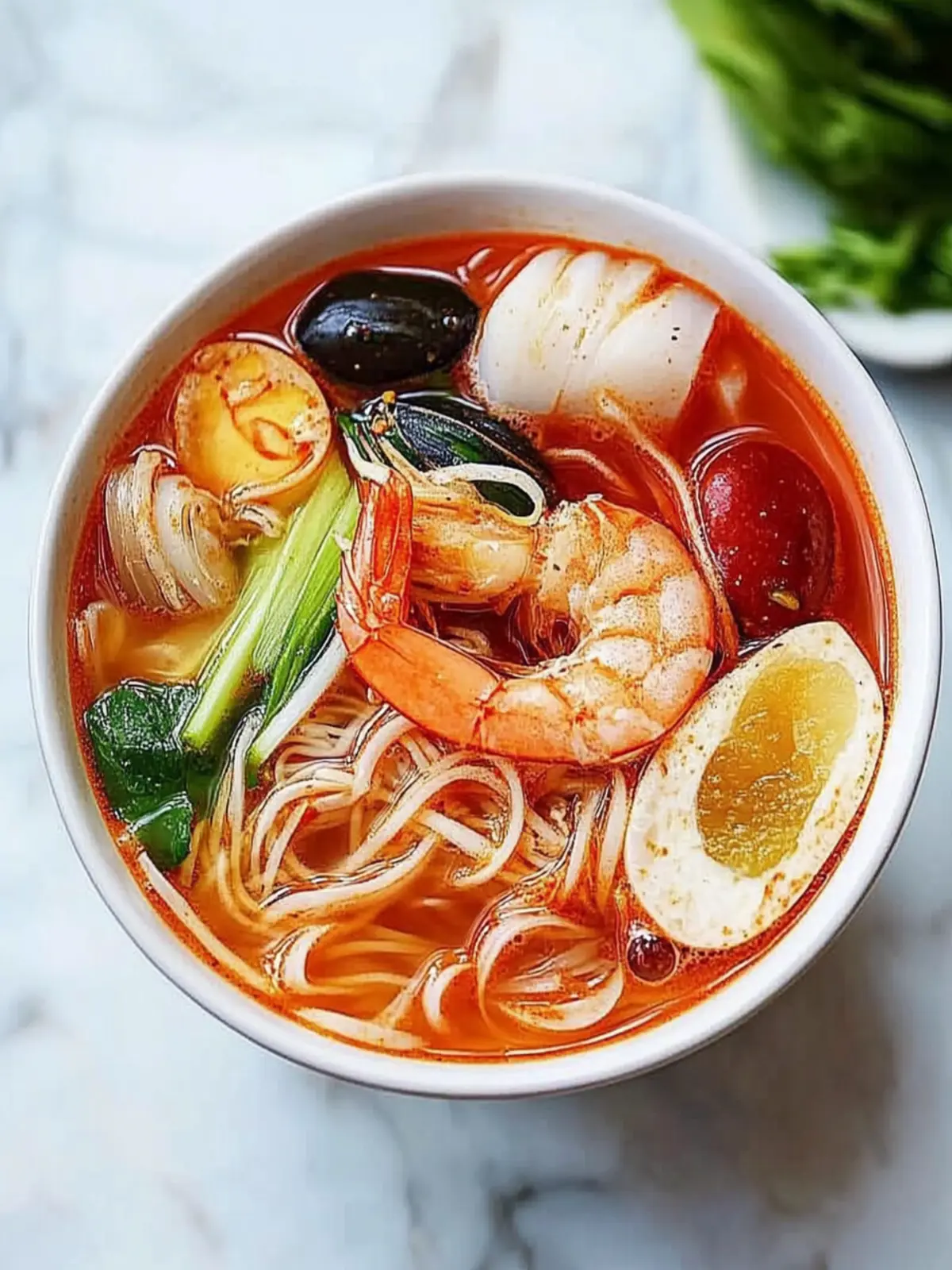As the sun begins to set and the day’s clutter starts to fade, there’s nothing quite like the comforting bowl of Jjamppong to lift your spirits. I first discovered this spicy seafood noodle soup on a cold evening that desperately called for warmth and flavor. Imagine the sound of fresh garlic sizzling in hot oil, curling into a delicious aromatic embrace. The vibrant color of gochujang and the rich broth come alive as they mingle, creating a dish that not only pleases the palate but also nourishes the soul.
This recipe is a treasure for anyone looking for a delectable, homemade alternative to fast food. With its quick preparation time of just 20 minutes, Jjamppong brings together tender seafood and crisp vegetables in a hearty broth, making it a fantastic choice for weeknight dinners or casual get-togethers with friends. Dive into this bowl of umami goodness that showcases the best of Korean cuisine, and let each bite transport you far away from the monotony of takeout. Ready to savor the delightful flavors of Jjamppong? Let’s get cooking!
Why is Jjamppong the ultimate comfort food?
Deliciously Bold Flavors: The combination of gochujang and aromatic seafood makes every spoonful an adventure for your taste buds.
Quick and Easy: With just 20 minutes to prepare, this dish fits perfectly into your busy weeknight schedule.
Wholesome Ingredients: Packed with nutrient-rich seafood and fresh vegetables, it’s a healthier alternative to fast food.
Perfect for Sharing: This recipe serves four people, making it ideal for a cozy dinner with loved ones or casual gatherings.
Versatile Customization: Feel free to add your favorite seafood or veggies to make this soup distinctly yours. Get ready to impress with your culinary skills!
Jjamppong Ingredients
For the Noodles
• Korean fresh noodles – these are essential for authentic Jjamppong; you can substitute with udon if needed.
For the Seafood
• Medium-sized shrimp – shrimp adds delightful sweetness, and feel free to use any other seafood you prefer.
• Manila clams – they provide a tender, briny flavor; try using mussels as a substitution if necessary.
• Squid – cut into rings for a fun texture that complements the noodles.
• Bay scallops or sea scallops – scallops enhance the dish’s richness; pick either based on availability.
For the Broth
• Cooking oil – it helps in stir-frying the aromatics to build depth of flavor.
• Garlic – minced for a pungent kick; fresh garlic elevates the taste profile beautifully.
• Onion – cut into pieces, it adds sweetness to the broth, balancing the spiciness.
• Gochujang – this Korean chili paste delivers that signature heat and umami that makes Jjamppong special.
• Gochugaru – the Korean chili powder enhances the flavor with a smoky kick; adjust to taste based on your spice preference.
• Chicken broth or bone broth – this serves as the heart of the soup, providing a rich, savory base.
For the Vegetables
• Napa cabbage – it softens beautifully and adds sweetness to the mix.
• Bok choy – its crisp texture adds a delightful crunch; you might try spinach as an alternative.
• Scallions – cut into strips for garnish; they brighten the dish and add a fresh note.
For Seasoning
• Soy sauce – adjust to taste for a savory depth in the broth.
• Salt – to enhance all the flavors; be cautious with the amount since the broth and soy sauce already have salt content.
Let’s gather these ingredients and get ready to create a vibrant bowl of Jjamppong that will wow your family and friends!
How to Make Jjamppong
-
Cook the noodles: Boil the Korean fresh noodles according to the package instructions until al dente. Drain and set aside to keep them from getting soggy.
-
Sauté the aromatics: In a pot, heat cooking oil over high heat. Add minced garlic and chopped onion, and stir-fry until fragrant and golden, about 2 minutes.
-
Add the seafood: Toss in the shrimp, clams, squid, and scallops along with gochujang and gochugaru. Stir well to combine, allowing the seafood to absorb the flavors for 2-3 minutes.
-
Create the broth: Pour in the chicken broth, then add napa cabbage and bok choy. Bring the mixture to a bubbling boil, letting it simmer for a couple of minutes to meld the flavors.
-
Season and combine: Drizzle in soy sauce and sprinkle salt to taste. Add the cooked noodles to the pot and stir gently for about 30 seconds before mixing in the freshly cut scallions. Turn off the heat and serve immediately.
Optional: Serve with a sprinkle of sesame seeds for an extra crunch.
Exact quantities are listed in the recipe card below.
Make Ahead Options
Jjamppong is a fantastic recipe for meal prep enthusiasts looking to save time during busy weeknights! You can prep the seafood (shrimp, clams, squid, and scallops) and vegetables (napa cabbage and bok choy) up to 24 hours in advance. Simply store them in an airtight container in the refrigerator to keep them fresh. Additionally, you can mix the broth ingredients, including gochujang, soy sauce, and seasonings, and keep it chilled for another 24 hours. When you’re ready to enjoy your Jjamppong, just bring the broth to a boil, add the prepped seafood and veggies, and cook for a few minutes. Finish by stirring in the noodles and scallions for a quick, delicious meal that tastes just as fresh as when made on the spot!
Expert Tips for Jjamppong
- Noodle Perfection: Always cook your Korean noodles just until al dente; overcooking them can make the soup mushy.
- Seafood Variety: Feel free to mix in your favorite seafood—just avoid overcooking to retain tenderness.
- Seasoning Balance: Taste your broth before adding too much soy sauce or salt, as both can easily overpower the dish.
- Fresh Ingredients: Use fresh vegetables for a crisp texture; adding wilted greens can detract from the overall flavor of Jjamppong.
- Garnishing Delight: Top with scallions and sesame seeds for a pop of flavor and visual appeal right before serving.
How to Store and Freeze Jjamppong
Fridge: Store leftover Jjamppong in an airtight container in the fridge for up to 3 days. This helps maintain the freshness of the seafood and veggies.
Freezer: If you want to enjoy your Jjamppong later, freeze it without the noodles for up to 2 months. Noodles can become mushy when thawed, so cook them fresh each time.
Reheating: To reheat, warm the soup over low heat on the stove until bubbling. Add freshly cooked noodles and stir in some water if needed to achieve the desired consistency.
Jjamppong Variations
Feel free to tailor this delightful dish to suit your taste and preferences!
- Seafood Swap: Substitute shrimp for scallops or crab for a unique twist and explore different seafood flavors.
- Heat Level: Adjust gochugaru based on your spice tolerance—add more for a fiery kick or reduce it for milder warmth.
- Veggie Boost: Enhance the nutrition by adding extra vegetables like carrots or bell peppers for color and crunch.
- Gluten-Free: Use gluten-free noodles, such as rice noodles or zucchini noodles, to make this dish gluten-free.
- Broth Base: Switch chicken broth with vegetable broth for a lighter, vegetarian-friendly option without sacrificing flavor.
- Herbal Infusion: Add fresh herbs like cilantro or basil just before serving to elevate the dish with aromatic freshness.
- Creamy Richness: Stir in a splash of coconut milk for a creamy broth that adds a tropical twist to your Jjamppong experience.
- Umami Enhancement: Incorporate a tablespoon of miso paste into the broth for a deeper umami flavor that will tantalize your taste buds.
Your Jjamppong journey can be as unique as your palate. Enjoy experimenting!
What to Serve with Jjamppong?
There’s nothing quite like pairing this spicy seafood noodle delight with the right side dishes to elevate your meal experience.
-
Steamed Jasmine Rice: The gentle aroma of jasmine rice serves as a perfect neutral base to balance the bold flavors in Jjamppong. A fluffy side like this ensures every bite is mouthwateringly satisfying.
-
Korean Pickled Radishes: These tangy, crunchy bites add a refreshing contrast to the warmth of the soup. Their zesty flavor helps cleanse the palate between delightful spoonfuls.
-
Sesame Spinach Salad: A light and nutritious option, this salad brings a nutty taste and great crunch. The earthy sesame oil perfectly complements the seafood profile of Jjamppong.
-
Kimchi: This iconic Korean side delivers a spicy, fermented kick, enhancing the complexity of the dish. It’s like having a culinary adventure in every bite!
-
Fried Tofu Bites: Crispy on the outside and soft within, these tofu bites soak up flavors beautifully. They add an enjoyable texture to your meal, making it even more delightful.
-
A Cold Beer or Soju: A light, crisp lager or a shot of soju pairs wonderfully with Jjamppong, helping to enhance the rich, savory experience of the dish while cooling your palate.
With these complementary options, you’ll create a truly memorable dining experience that nourishes both body and soul!
Jjamppong Recipe FAQs
What type of noodles should I use for Jjamppong?
Absolutely! For authentic Jjamppong, Korean fresh noodles are ideal, as they provide the right texture and flavor. If you can’t find them, udon noodles are a good substitute. Just be sure to adjust boiling times as needed!
How do I store leftover Jjamppong?
To keep your Jjamppong fresh, store the leftovers in an airtight container in the refrigerator for up to 3 days. This will help preserve the seafood and vegetable flavors. If you have mixed in the noodles, they may become soft, so it’s best to store them separately if you plan to have leftovers.
Can I freeze Jjamppong?
Yes, you can freeze Jjamppong, but it’s recommended to freeze it without the noodles to maintain the best quality. Store the soup in an airtight, freezer-safe container for up to 2 months. When ready to enjoy, simply thaw it in the refrigerator overnight and reheat on the stove, then add freshly cooked noodles.
What should I do if my Jjamppong is too salty?
Very common! If your Jjamppong turns out too salty, there are a couple of remedies. You can add a little water or unsalted broth to dilute the saltiness. If you want to keep the flavors intact, toss in some additional napa cabbage or other veggies; they will soak up some of the salt while adding volume. Taste as you go!
Can I use frozen seafood in Jjamppong?
Yes, absolutely! Using frozen seafood is a great option for this dish. Just ensure you thaw it beforehand and pat it dry to remove excess moisture. It’s important to avoid overcooking the seafood while preparing your Jjamppong, as it can become tough with prolonged cooking.
Is Jjamppong suitable for people with shellfish allergies?
While a delicious dish, Jjamppong does include seafood which can trigger shellfish allergies. If you or someone dining with you has such an allergy, I recommend substituting the seafood with firm tofu for a vegetarian version, or simply sticking with more vegetables like mushrooms and zucchini for texture.
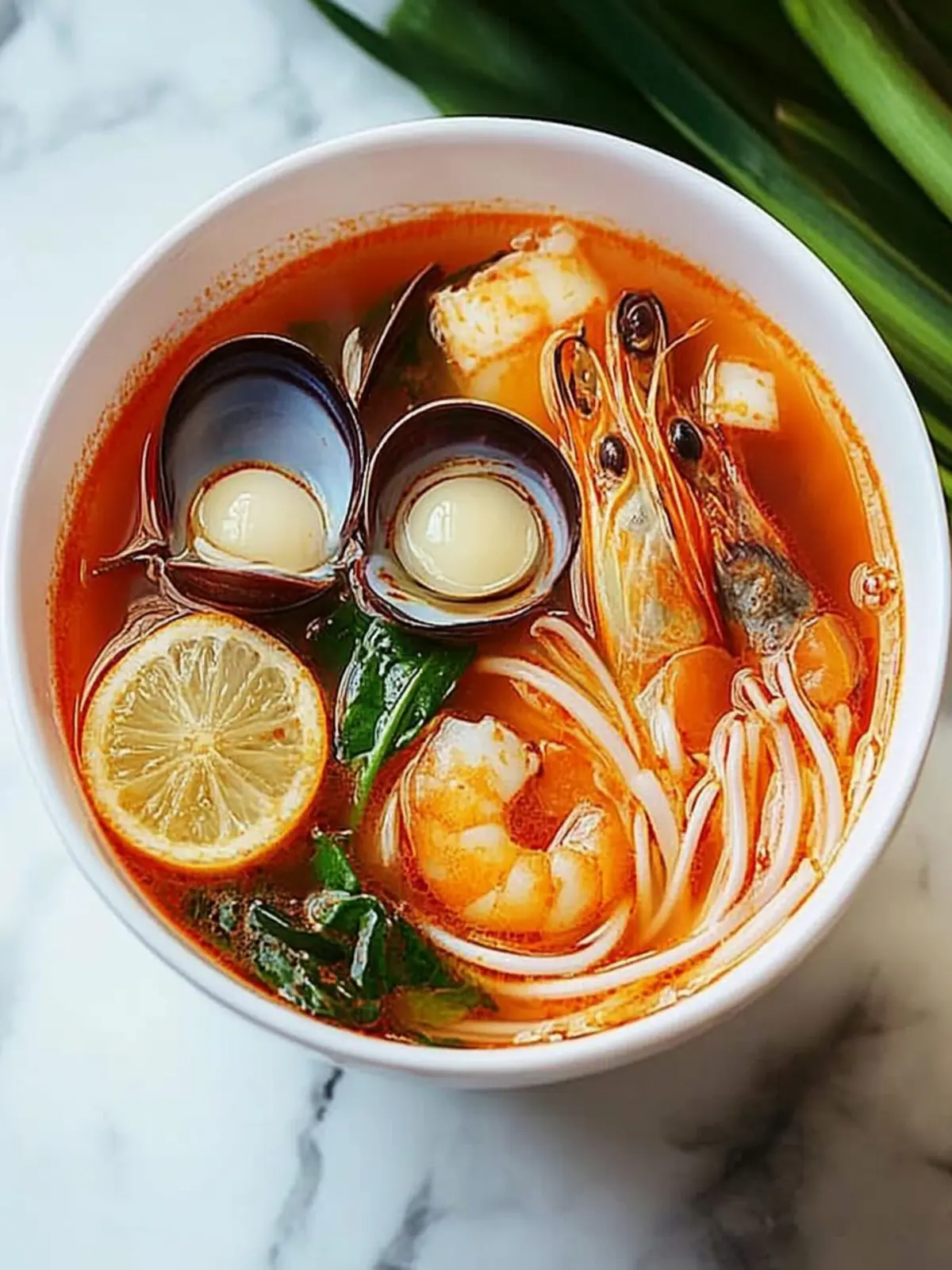
Savor Jjamppong: A Spicy Seafood Noodle Delight at Home
Ingredients
Equipment
Method
- Boil the Korean fresh noodles according to the package instructions until al dente. Drain and set aside.
- In a pot, heat cooking oil over high heat. Add minced garlic and chopped onion, and stir-fry until fragrant and golden, about 2 minutes.
- Toss in the shrimp, clams, squid, and scallops along with gochujang and gochugaru. Stir well to combine, allowing the seafood to absorb the flavors for 2-3 minutes.
- Pour in the chicken broth, then add napa cabbage and bok choy. Bring the mixture to a bubbling boil, letting it simmer for a couple of minutes to meld the flavors.
- Drizzle in soy sauce and sprinkle salt to taste. Add the cooked noodles to the pot and stir gently for about 30 seconds before mixing in the freshly cut scallions. Turn off the heat and serve immediately.

